Methodologies of Learning Served by Virtual Reality: A Case Study in Urban Interventions
Abstract
:Featured Application
Abstract
1. Introduction
2. Methods and Technologies
- Assess the incorporation of immersive ICTs and gamification in the educational process (specifically in the urban project).
- Assess the motivation and usability of the gamification platform by the users.
- Study and establish links between the profiles of the users and the results of the surveys.
- Determine the relationship between satisfaction, motivation and user experience.
3. Results
4. Discussion
- Professionals valued the system higher than the students as professionals have more knowledge on the field and know what to do, and what they are connecting is only the how to do it, which is the with the VR system. Meanwhile, students are learning both things, the what and the how at the same time, rather than connecting both aspects with previous knowledge.
- There were more similarities within the students’ group than within the professionals’ group. The students that participated in the experience were all at the same level of their academic career, while the variation in the professionals’ group was higher, as it depended on their professional specializations inside their fields.
- Professionals valued higher the systems that help them to transmit problems, solutions and ideas to both, the non-specialized and specialized, public. Students, valued higher the fact that this system helps them to understand the relationships between buildings and the space between them. The values were associated to those that were more used to working in their careers.
5. Conclusions and Future Work
Author Contributions
Funding
Conflicts of Interest
References
- Ambrose, S.A.; Bridges, M.W.; DiPietro, M.; Lovett, M.C.; Norman, M.K. How Learning Works; John Wiley & Sons: Hoboken, NJ, USA, 2010. [Google Scholar]
- Nilson, L.B. Teaching at Its Best; John Wiley & Sons: Hoboken, NJ, USA, 2010. [Google Scholar]
- Davis, B.G. Tools for Teaching; Jossey-Bass Publishers: San Francisco, CA, USA, 2009. [Google Scholar]
- Bransford, J.D.; Brown, A.L.; Cocking, R.R. How People Learn: Mind, Brain, Experience, and School; National Research Council: Washington, DC, USA, 1999; Volume 374. [CrossRef]
- Spence, L.D. The Case against Teaching. Change 2001, 33, 10–19. [Google Scholar] [CrossRef]
- Tigner, R.B. Putting Memory Research to Good Use: Hints from Cognitive Psychology. Coll. Teach. 1999, 47, 149–152. [Google Scholar] [CrossRef]
- Miller, M.T. Learning Motivation in the Postsecondary Classroom, Community Coll. J. Res. Pract. 2007, 31, 247–248. [Google Scholar] [CrossRef]
- Stage, A.; Muller, F.K.; Kinzie, A.; Simmons, J. Creating Learning Centered Classrooms: What does Learning Theory have to Say? ERIC Publications: Washington, DC, USA, 1998. [Google Scholar]
- Feldman, K.A. Identifying exemplary teachers and teaching: Evidence from student ratings. In The Scholarship of Teaching and Learning in Higher Education: An Evidence-Based Perspective; Springer: Dordrecht, The Netherlands, 2007; pp. 368–395. [Google Scholar] [CrossRef]
- Bligh, D.A. What’s the Use of Lectures? Jossey Bass Publishers: San Francisco, CA, USA, 2000. [Google Scholar]
- Bonwell, C.C.; Eison, J.A. Active Learning: Creating Excitement in the Classroom; ERIC Publications: Washington, DC, USA, 1991. [Google Scholar]
- Hake, R.R. Interactive-engagement versus traditional methods: A six-thousand-student survey of mechanics test data for introductory physics courses. Am. J. Phys. 1998, 66, 64–74. [Google Scholar] [CrossRef]
- Jones-Wilson, M.T. Teaching Problem-Solving Skills without Sacrificing Course Content: Marrying Traditional Lecture and Active Learning in an Organic Chemistry Class. J. Coll. Sci. Teach. 2005, 35, 42. [Google Scholar]
- McKeachie, W.J.; Hofer, B.K. McKeachie’s Teaching Tips: Strategies, Research, and Theory for College and University Teachers, 11th ed.; Houghton Mifflin Co.: Boston, MA, USA, 2002. [Google Scholar]
- Jewitt, C.; Kress, G.; Ogborn, J.; Tsatsarelis, C. Multimodal Teaching and Learning: The Rhetorics of the Science Classroom; A&C Black: London, UK, 2001. [Google Scholar] [CrossRef]
- Tulving, E. How many memory systems are there? Am. Psychol. 1985, 40, 385–398. [Google Scholar] [CrossRef]
- Vekiri, I. What is the value of graphical displays in learning? Educ. Psychol. Rev. 2002, 14, 261–312. [Google Scholar] [CrossRef]
- Dempster, F.N. Distributing and managing the conditions of encoding and practice. In Memory; Bjork, E.L., Ed.; Academic Press: Cambridge, MA, USA, 1996; pp. 317–344. [Google Scholar] [CrossRef]
- Dempster, F.N. Using Tests to Promote Classroom Learning; Greenwood Press: Westport, CT, USA, 1997. [Google Scholar]
- Roediger, H.L.; Karpicke, J.D. The Power of Testing Memory: Basic Research and Implications for Educational Practice, Perspect. Psychol. Sci. 2006, 1, 181–210. [Google Scholar] [CrossRef] [PubMed]
- Leamnson, R. Thinking about Teaching and Learning: Developing Habits of Learning with First Year College and University Students, 1st ed.; Stylus Publishing LLC: Sterling, VA, USA, 1999. [Google Scholar]
- Leamnson, R. Learning as Biological Brain Change, Chang. Mag. High. Learn. 2000, 32, 34–40. [Google Scholar] [CrossRef]
- Mangurian, L.P. Learning and teaching practice: The power of the affective. In Proceedings of the 25th Annual Lilly Conference on College Teaching, Oxford, OH, USA, 17–25 November 2005. [Google Scholar]
- Dede, C. Emerging influences of information technology on school curriculum. J. Curric. Stud. 2000, 32, 281–303. [Google Scholar] [CrossRef]
- Bower, M.; Cram, A.; Groom, D. Blended reality: Issues and potentials in combining virtual worlds and face-to-face classes. In Proceedings of the ASCILITE 2010: 27th Annual Conference of the Australasian Society for Computers in Learning in Tertiary Education, Sydney, Australia, 5–8 December 2010; pp. 129–140. [Google Scholar]
- Calvo, X.; Sánchez-Sepúlveda, M.; Fonseca, D.; van der Graaf, N.; Sans, M.; Gené, M.; Navarro, I.; Villagrasa, S.; Redondo, E. Qualitative assessment of urban virtual interactive environments for educational proposals. In Proceedings of the Sixth International Conference on Technological Ecosystems for Enhancing Multiculturality, Salamanca, Spain, 24–26 October 2018. [Google Scholar] [CrossRef]
- Riera, A.S.; Redondo, E.; Fonseca, D. Geo-located teaching using handheld augmented reality: Good practices to improve the motivation and qualifications of architecture students. Univers. Access Inf. Soc. 2015, 14, 363–374. [Google Scholar] [CrossRef]
- Suwa, M.; Tversky, B. What do architects and students perceive in their design sketches? A protocol analysis. Des. Stud. 1997, 18, 385–403. [Google Scholar] [CrossRef]
- Sanchez-Sepulveda, M.V.; Fonseca, D.; Calvo, X.; Navarro, I.; Franquesa, J.; Redondo, E.; Gene, M. Innovation in Urban Design Education. In Proceedings of the Sixth International Conference on Technological Ecosystems for Enhancing Multiculturality, Salamanca, Spain, 24–26 October 2018. [Google Scholar] [CrossRef]
- Valls, F.; Redondo, E.; Fonseca, D.; Torres-Kompen, R.; Villagrasa, S.; Martí, N. Urban data and urban design: A data mining approach to architecture education. Telemat. Inform. 2017, 35, 1039–1052. [Google Scholar] [CrossRef]
- Moreira, F.; Ferreira, M.J.; Santos, C.P.; Durão, N. Evolution and use of mobile devices in higher education: A case study in Portuguese Higher Education Institutions between 2009/2010 and 2014/2015. Telemat. Inform. 2017, 34, 838–852. [Google Scholar] [CrossRef]
- Bekele, M.K.; Champion, E. A Comparison of Immersive Realities and Interaction Methods: Cultural Learning in Virtual Heritage. Front. Robot. AI 2019, 6, 91. [Google Scholar] [CrossRef]
- Christou, C. Virtual reality in education. In Affective, Interactive and Cognitive Methods for E-Learning Design; Creating an Optimal Education Experience; IGI Global: Hershey, PA, USA, 2010. [Google Scholar] [CrossRef]
- Calvo, X.; Fonseca, D.; Sánchez-Sepúlveda, M.; Amo, D.; Llorca, J.; Redondo, E. Programming Virtual Interactions for Gamified Educational Proposes of Urban Spaces. In Proceedings of the International Conference on Learning and Collaboration Technologies, Las Vegas, NV, USA, 15–20 July 2018. [Google Scholar] [CrossRef]
- Sanchez-Sepulveda, M.V.; Fonseca, D.; Franquesa, J.; Redondo, E.; Moreira, F.; Villagrasa, S.; Peña, E.; Martí, N.; Canaleta, X.; Montero, J.A. Collaborative Design of Urban Spaces Uses: From the Citizen Idea to the Educational Virtual Development. In Human-Computer Interaction. Design Practice in Contemporary Societies; Lecture Notes in Computer Science; Kurosu, M., Ed.; Springer: Cham, Switzerland, 2019; Volume 11568, pp. 253–269. [Google Scholar] [CrossRef]
- Fonseca, D.; Villagrasa, S.; Navarro, I.; Redondo, E.; Valls, F.; Sánchez, A. Urban Gamification in Architecture Education. In Recent Advances in Information Systems and Technologies; Rocha, Á., Correia, A.M., Adeli, H., Reis, L.P., Costanzo, S., Eds.; Springer International Publishing: Cham, Switzerland, 2017; Volume 3, pp. 335–341. [Google Scholar] [CrossRef]
- Sanchez-Sepulveda, M.V.; Franquesa, J.; Fonseca, D. Teaching and Learning Urbanism in Architecture Schools. In Fearful Futures: Cities in the Twenty-First Century: Cultural Studies and the Question of Agency in the Twenty-First Century; The International Academic Forum (IAFOR): Barcelona, Spain, 2018; Available online: https://papers.iafor.org/proceedings/conference-proceedings-city2018/ (accessed on 27 November 2019).
- Fonseca, F.V.D.; Navarro, I.; Villagrasa, S.; Redondo, E. Sistemas de Visualización Gamificados para la mejora de la Motivación Intrínseca en Estudiantes de Arquitectura. In Proceedings of the CINAIC 2017—IV Congreso Internacional sobre Aprendizaje, Innovación y Competitividad, Zaragoza, Spain, 4–6 October 2017; pp. 209–214. [Google Scholar] [CrossRef]
- Fonseca, D.; Villagrasa, S.; Navarro, I.; Redondo, E.; Valls, F.; Llorca, J.; Gómez-Zevallos, M.; Ferrer, A.; Calvo, X. Student motivation assessment using and learning virtual and gamified urban environments. In Proceedings of the 5th International Conference on Technological Ecosystems for Enhancing Multiculturality, Cádiz, Spain, 18–20 October 2017. [Google Scholar] [CrossRef]
- Delamont, S.; Atkinson, P. Editorial. Qual. Res. 2010, 10, 635–637. [Google Scholar] [CrossRef]
- Teddlie, C.; Tashakkori, A. Mixed methods research: Contemporary issues in an emerging field. In Sage Handbook of Qualitative Research, 4th ed.; Denzin, N., Lincoln, Y., Eds.; SAGE Publications Inc: Thousand Oaks, CA, USA, 2011; pp. 285–299. [Google Scholar] [CrossRef]
- Sale, J.E.M.; Lohfeld, L.H.; Brazil, K. Revisiting the quantitative-qualitative debate: Implications for mixed-methods research. Qual. Quant. 2002, 36, 43–53. [Google Scholar] [CrossRef] [PubMed]
- Aizpurua, A.; Arrue, M.; Abascal, J. Quantitative assessment of mobile web guidelines conformance. Univers. Access Inf. Soc. 2011, 10, 33–49. [Google Scholar] [CrossRef]
- Sanchez-Sepulveda, M.; Fonseca, D.; Franquesa, J.; Redondo, E. Virtual interactive innovations applied for digital urban transformations. Mixed approach. Future Gener. Comput. Syst. 2019, 91, 371–381. [Google Scholar] [CrossRef]



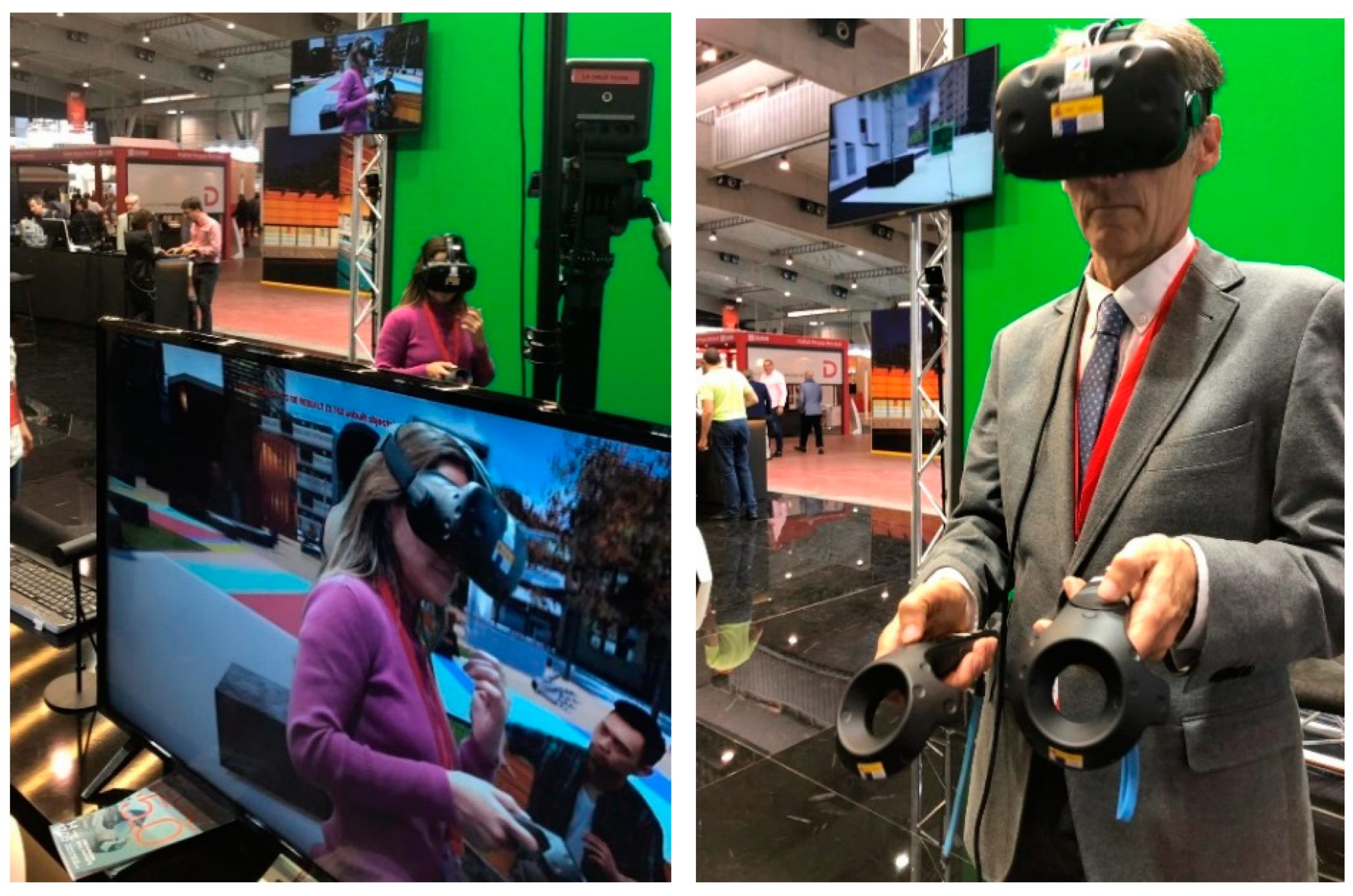

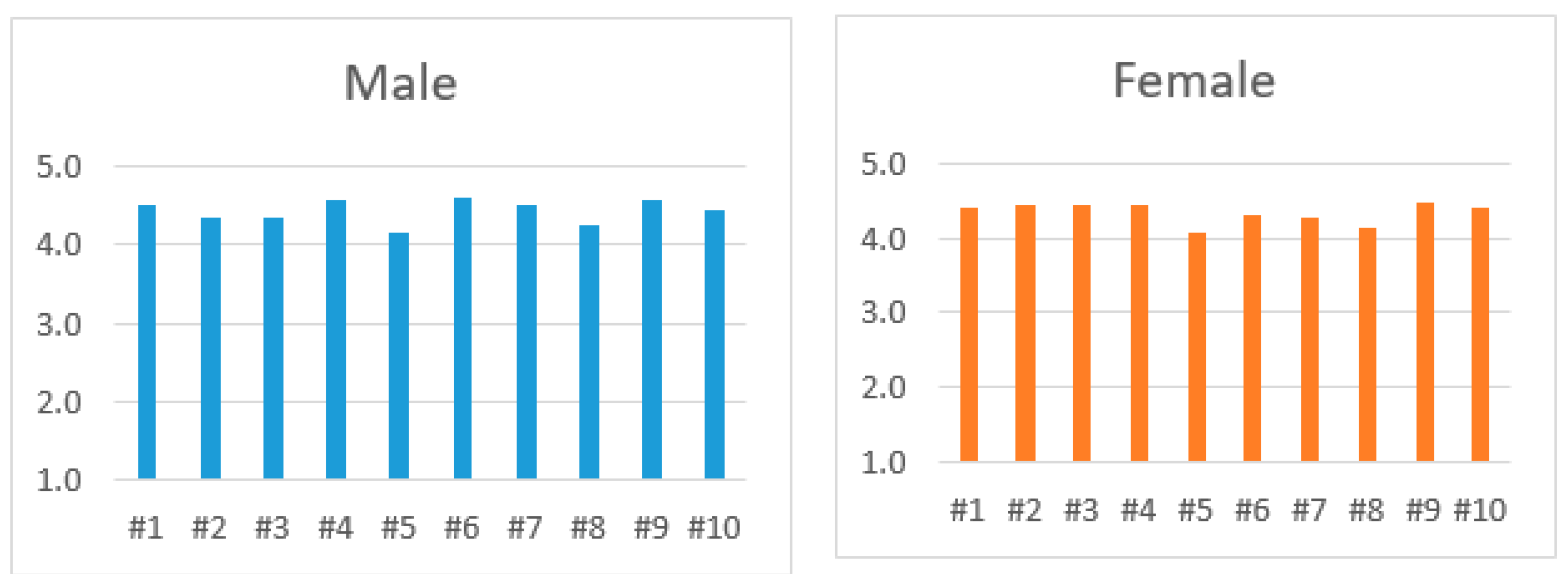

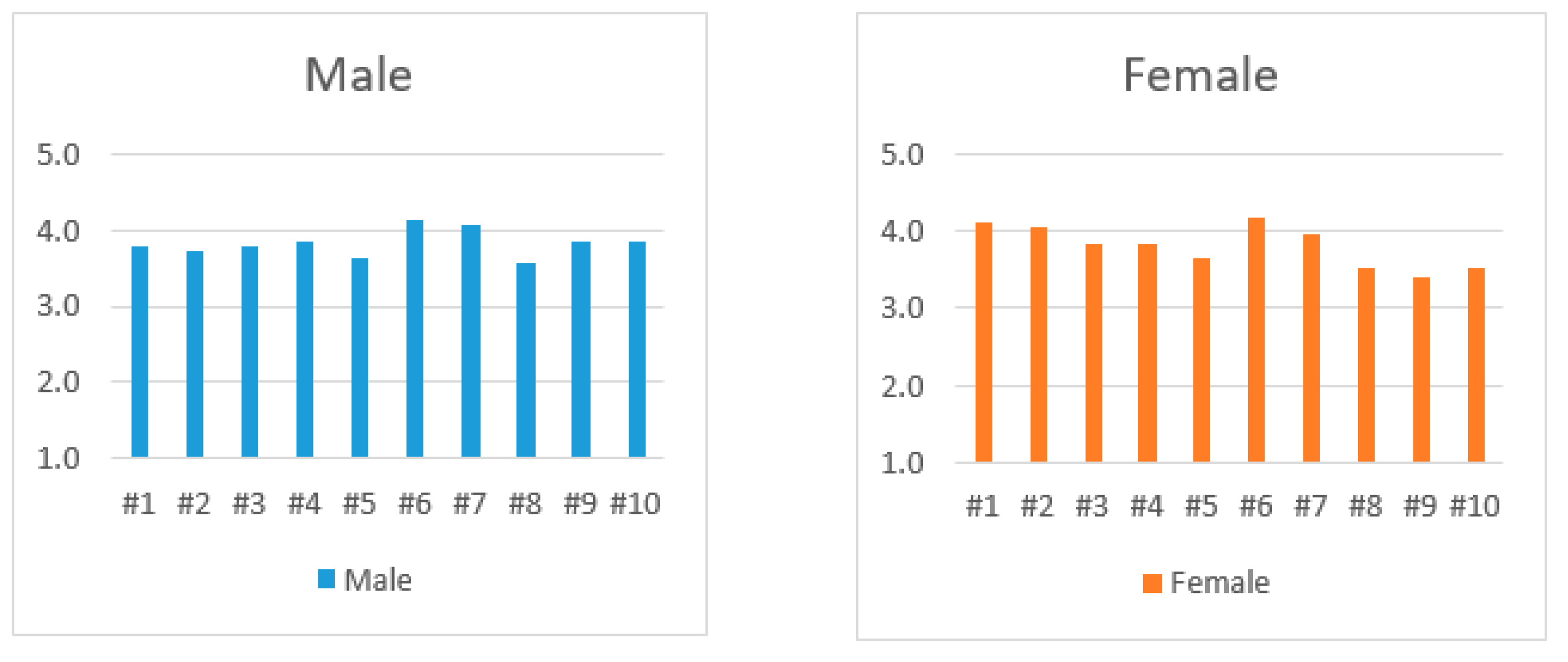
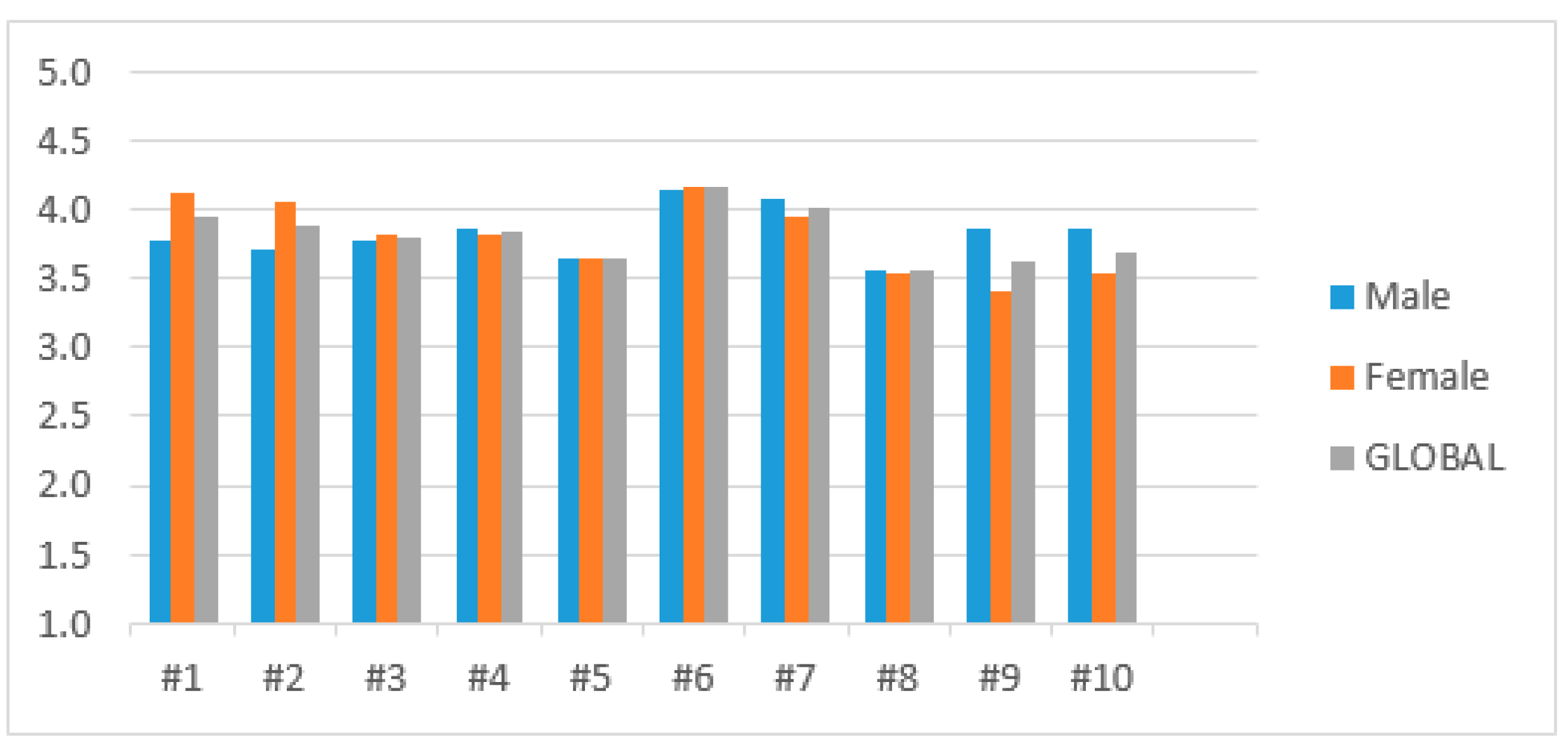
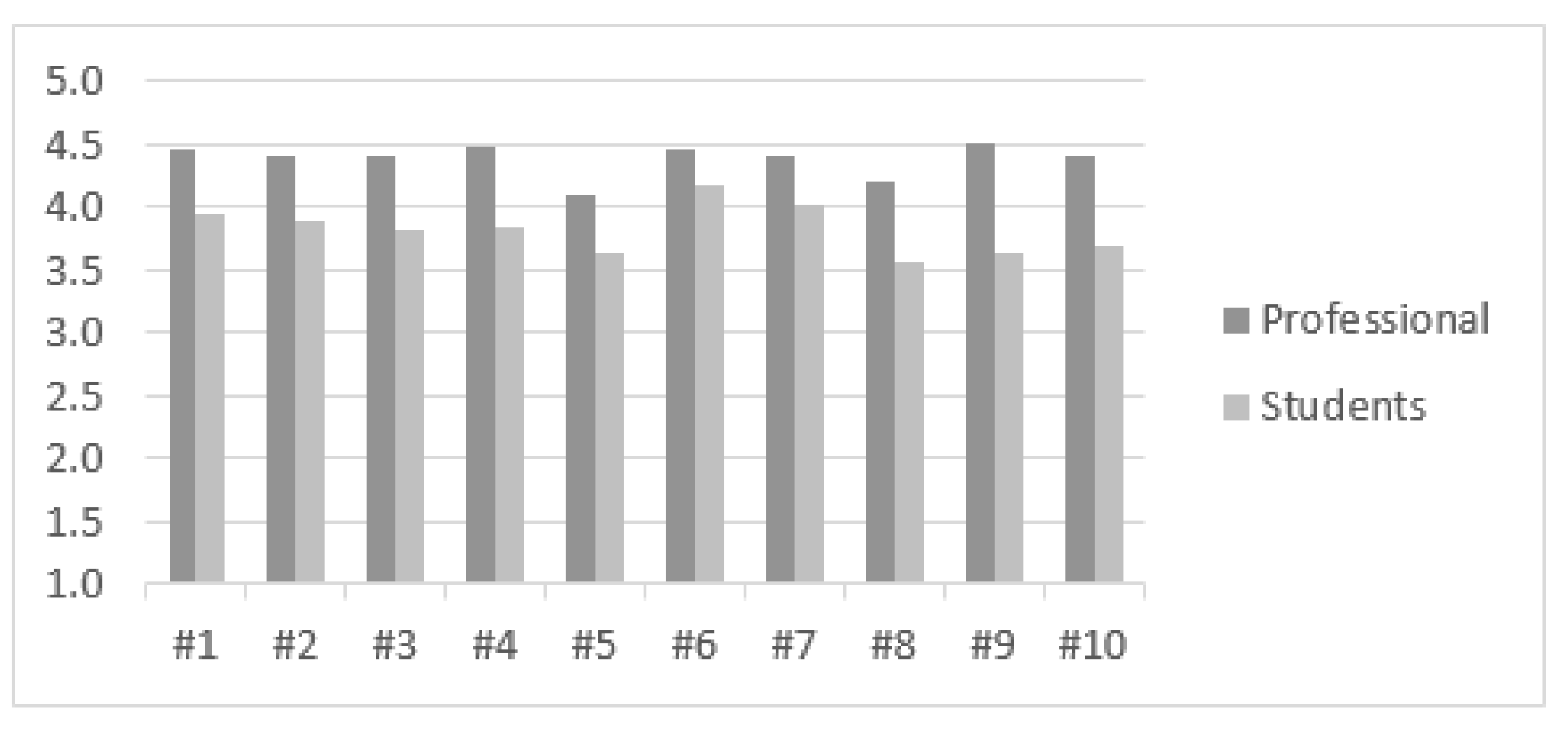
| Survey Statement # | Urbanism Competence |
|---|---|
| 1, 2 y 6 | Ability to comprehend the relations among people and buildings, between buildings and their surroundings, and buildings and spaces among them based on human scale and needs |
| 3 | Capability of making decisions (in projects, construction systems, organization, etc.) |
| 4 | Capability to communicate ideas, information, problems and solutions to a specialized and non-specialized public |
| 3 | Capability of acquiring self-critical capacity |
| 5 | Aptitude or ability to apply the basic formal, functional and technical principles to the conception and design of buildings and urban complexes, defining their general characteristics and benefits to be achieved |
| 7 | Aptitude or ability to develop building programs, considering the requirements of customers and users, analyzing precedents and location conditions, applying standards and establishing dimensions and relationships of spaces and equipment |
| 2 | Understanding the relationships between human behavior, the natural or artificial environment and objects, according to human requirements and scale |
| Disagree -> Agree | |||||
|---|---|---|---|---|---|
| The interactive virtual reality (VR) system helps: | 1 | 2 | 3 | 4 | 5 |
| |||||
| |||||
| |||||
| |||||
| |||||
| |||||
| |||||
| Knowing the interactive VR system: | 1 | 2 | 3 | 4 | 5 |
| |||||
| |||||
| |||||
© 2019 by the authors. Licensee MDPI, Basel, Switzerland. This article is an open access article distributed under the terms and conditions of the Creative Commons Attribution (CC BY) license (http://creativecommons.org/licenses/by/4.0/).
Share and Cite
Sanchez-Sepulveda, M.V.; Torres-Kompen, R.; Fonseca, D.; Franquesa-Sanchez, J. Methodologies of Learning Served by Virtual Reality: A Case Study in Urban Interventions. Appl. Sci. 2019, 9, 5161. https://doi.org/10.3390/app9235161
Sanchez-Sepulveda MV, Torres-Kompen R, Fonseca D, Franquesa-Sanchez J. Methodologies of Learning Served by Virtual Reality: A Case Study in Urban Interventions. Applied Sciences. 2019; 9(23):5161. https://doi.org/10.3390/app9235161
Chicago/Turabian StyleSanchez-Sepulveda, Monica V., Ricardo Torres-Kompen, David Fonseca, and Jordi Franquesa-Sanchez. 2019. "Methodologies of Learning Served by Virtual Reality: A Case Study in Urban Interventions" Applied Sciences 9, no. 23: 5161. https://doi.org/10.3390/app9235161
APA StyleSanchez-Sepulveda, M. V., Torres-Kompen, R., Fonseca, D., & Franquesa-Sanchez, J. (2019). Methodologies of Learning Served by Virtual Reality: A Case Study in Urban Interventions. Applied Sciences, 9(23), 5161. https://doi.org/10.3390/app9235161






